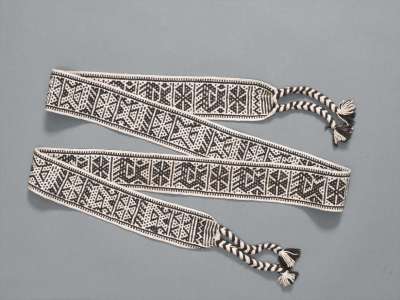Faja
The Huichol (or Wixárika) are the modern day descendants of the Aztecs, who number several thousand people in the west Mexican states of Nayarit, Zacatecas and Jalisco. This belt reflects the value of maintaining traditions and their values.
In Mexico, the Huichol, the Amuzgo, the Triqui, the Mixtec, the Tzotzil (Maya) and the Tzeltal (Maya) are among those who have retained the use of the backstrap loom. Weavers from all these cultures are highly respected for their artistry and skill, which each generation inherits from the last. The Huichol, for example, specialise is double-weaving sashes and shoulder-bags: with this technique, designs are reversed on the opposite side of cloth
The weaver has used off-white and dark-brown wool, probably hand-spun, and woven this man’s sash on the backstrap loom. The Huichol specialise is double-weaving sashes and shoulder-bags. This means that designs are reversed on the opposite side of cloth. Designs include stylized deer, six-petal flowers (peyote) and X-shaped motifs. The pioneering work done c. 1900 by Carl Lumholtz shows the antiquity of many woven Huichol designs. The sash has side selvages; the trailing ends have been braided in two strands: each strand finishes in a thick tassel. This is a good example of a man’s wool sash from a region where they are still worn; it also illustrates the art of double weaving.
Purchased by the donor in December 1966
In Mexico, the Huichol, the Amuzgo, the Triqui, the Mixtec, the Tzotzil (Maya) and the Tzeltal (Maya) are among those who have retained the use of the backstrap loom. Weavers from all these cultures are highly respected for their artistry and skill, which each generation inherits from the last. The Huichol, for example, specialise is double-weaving sashes and shoulder-bags: with this technique, designs are reversed on the opposite side of cloth
The weaver has used off-white and dark-brown wool, probably hand-spun, and woven this man’s sash on the backstrap loom. The Huichol specialise is double-weaving sashes and shoulder-bags. This means that designs are reversed on the opposite side of cloth. Designs include stylized deer, six-petal flowers (peyote) and X-shaped motifs. The pioneering work done c. 1900 by Carl Lumholtz shows the antiquity of many woven Huichol designs. The sash has side selvages; the trailing ends have been braided in two strands: each strand finishes in a thick tassel. This is a good example of a man’s wool sash from a region where they are still worn; it also illustrates the art of double weaving.
Purchased by the donor in December 1966
Object Summary
- Accession Loan No.
- 149/2007/16
- Category
- Ethnography
- Collection Class
- Clothing and accessories
- Collection Area Region
- CENT
- Material
- wool
- Common Name
- faja
- Simple Name
- sash
- Period Classification
- Modern (1945-)
- Production Country
- Mexico
- Production Year High
- 12/1966


